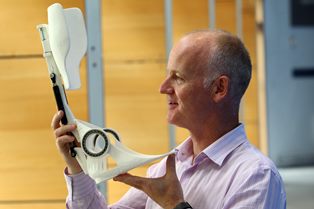3D-printed foot orthotics project awarded £77k SBRI grant
12 January 2015
Glasgow Caledonian University (GCU) in partnership with the University of Newcastle and Newcastle-based Peacocks Medical Group have been awarded £77,000 funding for the design and manufacture of foot orthotics using 3D-printing technologies.
The grant has been awarded by the Small Business Research Initiative (SBRI) Healthcare, an NHS England initiative, championed by the newly formed Academic Health Science Networks to develop innovative products and services that address unmet health needs. The funding was awarded following a call to address challenges in improving diagnosis, self-management and prevention of musculoskeletal disorders.
The GCU team, led by Dr Gordon Hendry and Professor Jim Woodburn, will work with Peacocks Medical Group and researchers from Newcastle University on the ‘FootFEMan’ project, which will utilise a computational engineering tool called finite element analysis to improve the functional design of orthotic devices for individual patients.
The improved personalised design will then be printed using 3D-printing techniques developed previously in the team’s award-winning EU-funded project, A-FOOTPRINT.

A foot orthotic developed by the A-FOOTPRINT
project
Dr Hendry said, “We are confident that we can successfully 3D print new orthotic insole devices. This project will now enable us to improve each orthotic tailored to the individual patient according to whatever foot problem they have.
“We will test the new products in controlled clinical studies here at GCU to see if we can improve foot function during walking and further lessen disabling foot symptoms.”
Professor Woodburn added: “GCU’s collaborative partnership with Peacocks will enable them to maintain and grow their market position as the leading SME developing innovative and knowledge-based orthotic products.”
Disabling foot and ankle conditions affect approximately 200 million European citizens. Over €300 million per annum is spent treating many of these people with orthoses and splints, often relying on hand-crafted manufacturing techniques which are slow, costly and difficult to reproduce.
With an increasingly ageing population and a growing health burden in long-term conditions, the global market for custom foot orthoses continues to grow.
More information
The A-FOOTPRINT project website: www.afootprint.eu/